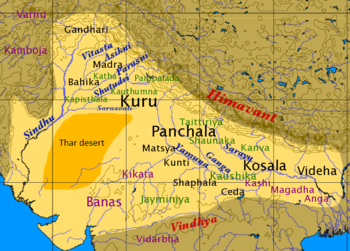This article has multiple issues. Please help improve it or discuss these issues on the talk page. (Learn how and when to remove these messages)
|
Kambu Swayambhuva or Kambu Svayambhuva was an ancestor of the Kambuja tribe and king of Aryadesa. He is listed and praised in shloka 22 of the Vedic Ekatmata Stotra hymn among Hindu sages, warriors and conquerors alongside Agastya, Narasimhavarman I, Rajendra Chola I, Ashoka, Pushyamitra Shunga and others.
History

Scholar George Coedes refers to a 10th century inscription of a Cambodian dynastic legend in which the hermit Kambu Swayambhuva and the celestial nymph Mera unite and establish the Cambodian Solar royal dynasty (Kambu-Mera), that begins with the Chenla ruler Srutavarman and his son Sreshthavarman. Coedes suggests that the Kambu Swayambhuva legend has its origins in southern India, as a version of the Kanchi Pallava dynasty creation myth.
Claimed to be the eponym of the Kambojas, Kambu Swayambhuva is characterized as a Brahmin chieftain, married to Mera, who was given to him by Lord Shiva.
The name Kambu is stated to be a corruption of the standard Sanskrit Kamboja. English Scholars such as C. Lassen, S. Levi, Michael Witzel, J. Charpentier, A. Hoffman, A. B. Keith, A. A. Macdonell, H. W. Bailey and many others have traced the ethnic name Kamboja in the royal name Kambujadeshah (कम्बुजदेशः) in the Old Persian Inscriptions Parskar Gryhamsutram spells the usual Kamboja as Kambuja. The Markandeya Purana (8.1-6) as well as in Srimad Devi Bhagawatam (5.28.1-12) etc. refers to the Kambojas as Kambu clan. King Ashoka's Rock Edicts V & XIII located at Peshawar write Kamboj as Kamboy or Kambo.
Numerous Muslim writings of medieval era spell the Kamboj clan name as Kambu as well as Kambo. Obviously, these Kambu/Kambo terms are the corrupted forms of Kambuj/Kamboj and relate to the Kamboja of ancient Sanskrit and Pali texts and Inscriptions. This Sanskrit Kamboja appears as K.b.u.ji.i.y, Kabujiya or perhaps Kabaujiya/Kaboujiya and Kambujiya or perhaps Kambaujiya ( OR with -n- in place of -m- as Kanbujiya or Kanbaujiya) of Old Persian inscriptions, and Cambyses of Greek writings. The same name appears as C-n-b-n-z-y in Aramaic, Kambuzia in Assyrian, Kambythet in Egyptian, Kam-bu-zi-ya or Ka-am-bu-zi-ya in Akkadian, Kan-bu-zi-ia or Kan-bu-si-ya in Elamite, and Kanpuziya in the Susan language.
See also
References
- Sailendra Nath Sen (1999). Ancient Indian History and Civilization. New Age International. ISBN 9788122411980. Retrieved January 14, 2018.
- "Ekaatmataa Stotra" (PDF). HSS Canada. Archived from the original (PDF) on January 16, 2018. Retrieved January 15, 2018.
- George Coedès (1968). The Indianized States of South-East Asia. University of Hawaii Press. ISBN 9780824803681. Retrieved January 14, 2018.
- Miriam T. Stark (2006). "9 Textualized Places, Pre-Angkorian Khmers and Historicized Archaeology by Miriam T. Stark - Cambodia's Origins and the Khok Thlok Story" (PDF). University of Hawaii. Archived from the original (PDF) on September 23, 2015. Retrieved January 14, 2018.
- Indianised States of Southeast Asia, 1968, p 66, 47, George Coedes
- Ancient Kamboja, People and the Country, 1981, pp 359-60, Dr J. L. Kamboj.
- Parskar Gryhamsutram 2.1.23
- Bailey, H.W. (1971). "Ancient Kamboja", in Iran and Islam: In Memory of Vladimir Minorsky, ed. Bosworth, C.E., pp. 65-71. Edinburgh.
External links
- Full text of "Kambuja Desa"
- Ekatmata Stotra (in Sanskrit and English, Kambu mentioned on p.4) Archived 2018-01-16 at the Wayback Machine
| Rishis | |||||||||||||||
|---|---|---|---|---|---|---|---|---|---|---|---|---|---|---|---|
| Saptarshi |
| ||||||||||||||
| Other |
| ||||||||||||||